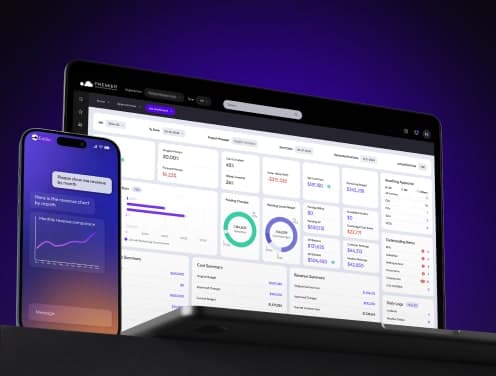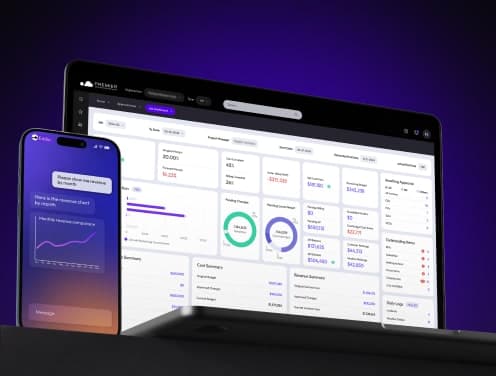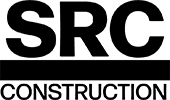
Construction Accounting Methods Explained: Expert Tips for Making the Right Choice [2025 Guide]
Did you know that 91.5% of construction projects go over budget, over schedule, or both? The proper construction accounting methods can make all the difference between financial chaos and project success.
In fact, construction accounting is a specialized practice that goes beyond traditional financial management. When dealing with accounting for construction companies, you need systems that handle decentralized job sites, complex cost tracking, and delayed revenue—the majority of projects last more than a year, creating unique challenges for accounting for construction projects. However, there's good news: 67% of firms reported an average 14% increase in profitability after adopting construction-specific accounting software.
That's why we've created this comprehensive guide to help you understand your options and make the best choice for your business. From cash basis to percentage-of-completion, we'll break down each method in simple terms and show you how to select the approach that will keep your projects profitable and compliant.
What makes construction accounting different?
Unlike standard accounting, construction accounting deals with unique financial challenges that don't exist in other industries. Construction companies face unique challenges that necessitate specialized accounting approaches and systems.
Project-based financial tracking
Construction accounting focuses on individual projects rather than ongoing operations. Every project operates as its own profit center with unique requirements, costs, and revenue streams. This project-centred approach fundamentally changes the way financial tracking works.
For construction companies, profitability must be measured at the project level. Each job requires separate tracking of materials, labour, equipment, and subcontractor costs. This granular approach allows you to spot problems before they spiral out of control.
Think about it this way: a retail business tracks overall store performance, but in construction, you're essentially running dozens of mini-businesses simultaneously. One underperforming project can drain profits from otherwise successful jobs.
Job costing becomes the foundation of construction accounting, allowing you to:
- Track every dollar spent on specific projects
- Compare actual expenses against estimated costs
- Make real-time adjustments to preserve profit margins
According to industry data, material price increases can jump by an average of 25% annually, with some items spiking by as much as 100%. Without proper project-based tracking, these fluctuations can quickly destroy your budget.
Decentralized job sites and cost control
Construction accounting must address the reality that production happens across multiple locations rather than in a centralized facility. Your company might have a head office, but the actual work occurs at numerous job sites, each with unique challenges and requirements.
This decentralized nature creates several accounting complications. First, your workforce and equipment constantly move between sites, requiring you to track travel expenses and equipment transportation costs. Second, you need systems that can handle different wage scales and compliance requirements that vary by location.
Furthermore, managing cash flow becomes extraordinarily complex as expenses accumulate across multiple job sites, with invoices in disconnected systems and budgets drifting from projections. Traditional financial oversight, which relies on spreadsheets and periodic reporting, creates significant delays in identifying problems.
Construction cost tracking software helps address these challenges by consolidating real-time financial data. Instead of waiting for monthly budget reviews, you can spot cost discrepancies within hours and make adjustments before profitability suffers.
Long-term contracts and delayed revenue
Construction projects typically span multiple accounting periods or even years. This extended timeline creates unique revenue recognition challenges that simply don't exist in businesses with immediate product delivery.
Consider this stark difference: a retailer recognizes revenue immediately when a product is sold, but construction companies must carefully manage revenue recognition across the project's entire lifecycle. Methods such as Percentage of Completion (PCM) and Completed Contract Method (CCM) become essential for accurately matching revenue with project progress.
Additionally, construction billing often ties to specific milestones or completion percentages. This means your cash flow timing rarely aligns with your expense timing – you might be spending heavily on materials and labour long before receiving corresponding payments.
The extended timeline also exposes you to cost fluctuations. The price of labour and materials can change considerably during a project, yet these fluctuations are difficult to predict. You can't simply stockpile building materials in advance to hedge against price increases.
Under ASC 606, construction companies face additional complexity in determining whether revenue should be recognized over time or at a single point in time. This determination depends on whether customers receive benefits as work progresses or only upon completion.
Understanding these fundamental differences helps explain why construction requires specialized accounting methods tailored to these industry-specific challenges.
The four primary construction accounting methods
Construction companies face a critical decision when selecting which accounting method to implement. Let's examine the four primary construction accounting methods and what makes each one distinct.
1. Cash basis method
The cash basis method offers simplicity as its primary advantage. With this approach, you record revenue when you receive payment and expenses when you pay bills – regardless of when work actually takes place. For example, if a client pays a deposit for a new building, you immediately recognize that deposit as revenue, even before starting construction.
For small construction businesses, this straightforward method provides a clear view of available cash and simplifies tax planning. The IRS allows construction companies to use this method if they have less than $30 million in average annual revenue over the past three years.
While convenient, cash basis accounting doesn't always paint an accurate picture of your financial health, especially when there's a significant gap between completing work and receiving payment. Moreover, this method isn't recognized under Generally Accepted Accounting Principles (GAAP), which may limit your ability to secure financing or bonding.
2. Accrual basis method
The accrual method follows the matching principle, recognizing revenue when it is earned and expenses when they are incurred, regardless of when payment is made. This approach provides a more accurate representation of your company's economic reality.
For instance, if you complete and bill a job on December 15th with 30-day payment terms, you'll create a receivable account and recognize that revenue immediately – even though payment won't arrive until January.
Because it more accurately reflects a project's financial progress, banks and bonding agencies typically prefer the accrual method. The IRS requires contractors earning $25 million or more in average gross receipts over three years to use accrual accounting.
While more complex than the cash basis, accrual accounting provides a more comprehensive financial picture. On the downside, you might need to pay taxes on income before actually receiving payment, potentially creating cash flow challenges.
3. Percentage of completion method (PCM)
The percentage of completion method enables companies to recognize revenue and expenses incrementally as work progresses, rather than waiting until the project is completed. This method primarily applies to long-term contracts spanning multiple accounting periods.
PCM relies on three key components:
- Total contract price
- Total estimated costs
- Costs incurred to date
To calculate completion percentage, most contractors use the cost-to-cost formula: dividing costs incurred to date by total estimated costs. For example, if your $1 million project has $800,000 in estimated costs and you've spent $400,000 so far, the project is 50% complete – allowing you to recognize $500,000 in revenue.
PCM offers several advantages, including smoother earnings patterns and better alignment with economic reality. Nevertheless, it requires reliable cost estimation and progress measurement. Inaccurate estimates can lead to significant misstatements of revenue and profit.
4. Completed contract method (CCM)
The completed contract method defers the recognition of both revenue and expenses until a project is fully completed. This approach makes sense when the total contract value or completion date is uncertain.
CCM works well for projects where final costs are challenging to estimate or when there's uncertainty about collecting payments from customers. The IRS generally allows contractors averaging less than $27 million in annual revenue to use this method for contracts completed within two years.
This method offers several advantages, including minimizing the risk of overstating profits and eliminating the need to estimate costs. It's particularly useful for short-term projects or when dealing with uncertain outcomes.
The primary disadvantage is that CCM can create significant fluctuations in your income statement as projects finish simultaneously. Additionally, this approach doesn't reflect ongoing financial performance, making it challenging to demonstrate consistent revenue generation to potential investors or lenders.
Each method has distinct advantages depending on your company's size, project types, and financial reporting needs. Selecting the proper construction accounting method is crucial for maintaining financial clarity, ensuring tax compliance, and enhancing operational efficiency.
Cash vs. Accrual: Which one fits your business?
Choosing between cash and accrual accounting isn't just a paperwork decision—it's a strategic choice that impacts everything from tax liability to project profitability. Most construction professionals find themselves wrestling with this fundamental decision, not realizing how significantly it shapes their financial picture.
When cash basis works best
Cash basis accounting shines for smaller construction operations with straightforward financial needs. Under this method, you only record revenue when you receive payment and expenses when you pay bills—creating a clear picture of your actual cash position.
This approach works best for:
- Small contractors averaging less than $26 million in annual revenue over the past three years
- Companies completing most projects within a single fiscal year
- Businesses prioritizing simplicity in their accounting practices
The simplicity of cash accounting offers distinct advantages. First, it provides a real-time view of available cash, making day-to-day operations more straightforward to manage. Second, it provides flexibility in managing taxable income by timing when you receive payments and pay expenses.
As one contractor noted, "Cash basis accounting helped us stay solvent during our early years when the timing of payments was unpredictable."
Why is accrual often required
Despite the simplicity of cash accounting, accrual accounting becomes necessary as your construction business grows. Primarily, this happens because the IRS mandates accrual accounting for contractors exceeding certain revenue thresholds.
Currently, construction companies must switch to accrual accounting when:
- Average annual revenue exceeds $26 million over three years
- GAAP-compliant financial statements are required
- Banks or bonding companies require it for loans or bonding capacity
Many construction companies voluntarily switch around the $10 million revenue mark, recognizing accruals' benefits before being legally required to change.
Accrual accounting follows the matching principle—recognizing revenue when earned and expenses when incurred, regardless of when money changes hands. This approach aligns with how construction projects actually progress and provides a more accurate representation of your company's economic reality.
How each method affects job costing
The accounting method you choose dramatically impacts your ability to track and analyze project performance. This connection between accounting method and job costing affects daily operational decisions.
With cash basis accounting, job costing becomes challenging because:
- Timing differences between work performed and payments received distort project profitability
- Large swings in financial results occur simply due to payment timing
- Comparing profitability between projects or time periods becomes unreliable
Imagine completing a primary project phase in July but not receiving payment until September. Cash accounting would show September as highly profitable, though the work occurred in July—creating a disconnect between financial reports and project reality.
Conversely, accrual accounting enhances job costing by:
- Matching revenues with the related expenses in the same period
- Providing more accurate project profitability analysis
- Allowing for better identification of cost overruns
- Supporting more reliable comparisons between projects
Although accrual accounting requires more work to maintain, most construction professionals find it worth the effort for its superior job costing capabilities. Above all, accrual accounting gives you the data needed to make better pricing and operational decisions across multiple projects simultaneously.
Understanding long-term contract methods
Long-term contracts pose unique accounting challenges that require specialized methods. For construction projects spanning multiple years, two approaches stand out: the Percentage of Completion Method (PCM) and the Completed Contract Method (CCM). Understanding when and how to apply each method can significantly impact your financial reporting and tax liability.
How PCM tracks progress and revenue
PCM allows you to recognize revenue and expenses incrementally as your project progresses, providing a continuous financial snapshot throughout the project lifecycle. This method relies on three fundamental components: the total contract price, the total estimated costs, and the costs incurred to date.
Most contractors apply PCM using a cost-to-cost formula. Simply divide your actual costs to date by the total estimated costs to determine the percentage complete. Then multiply this percentage by the contract value to calculate revenue earned.
For instance, if your $1 million project has $800,000 in estimated costs and you've spent $400,000 so far:
- Percentage complete: $400,000 ÷ $800,000 = 50%
- Revenue recognized: 50% × $1,000,000 = $500,000
PCM requires meticulous work-in-progress (WIP) reporting to track overbilling or underbilling situations. An underbilling occurs when you've earned more revenue than you've billed, creating an asset on your balance sheet. Conversely, overbilling creates a liability as you've billed more than you've earned.
When CCM is a better fit
Unlike PCM, the Completed Contract Method defers all revenue and expense recognition until the project reaches substantial completion. No financial activity appears on your income statement until the contract concludes, consequently creating a cleaner accounting process throughout the project.
CCM typically works best in specific scenarios:
- Projects with uncertain costs or completion timelines
- Short-term contracts that will finish within two years
- Situations where collecting payments from customers is uncertain
- Projects where reliable progress estimation is difficult
While CCM simplifies ongoing accounting, be aware that it can lead to significant fluctuations in income when multiple projects finish simultaneously. Furthermore, since it doesn't reflect ongoing financial performance, it may complicate relationships with stakeholders who require regular performance updates.
Tax implications of each method
The IRS generally requires construction contractors to use PCM for long-term contracts crossing tax years. Yet two notable exceptions exist:
First, the small contractor exception applies when: (1) your contract will be completed within two years, and (2) your average annual gross receipts don't exceed $25 million for the three preceding tax years.
Second, home construction contracts qualify for CCM regardless of contractor size. These contracts involve buildings with four or fewer dwelling units, with at least 80% of costs related to the construction or improvement of these units.
From a strategic perspective, CCM offers clear tax advantages through deferral. By postponing revenue recognition until project completion, you can delay tax liability, improving capital retention and reinvestment capacity during construction. Additionally, this deferral potentially allows better long-term tax planning as you can anticipate income recognition upon completion.
Nonetheless, transitioning between methods requires careful planning and execution. Companies must file Form 3115 to request an accounting method change with the IRS. Financial modelling beforehand can illustrate how switching methods impacts cash flow, tax liability, and investment potential.
Remember that while tax rules still reference PCM and CCM specifically, GAAP now follows ASC 606, which uses "over-time" recognition (similar to PCM) and "point-in-time" recognition (similar to CCM) based on specific criteria.
How ASC 606 changes revenue recognition
In 2014, the Financial Accounting Standards Board (FASB) introduced ASC 606, "Revenue from Contracts with Customers," creating a standardized framework for revenue recognition across all industries. This standard fundamentally changes how construction companies record revenue and report financial performance.
The 5-step model explained
ASC 606 establishes a comprehensive five-step process that construction companies must follow:
- Identify the contract - Determine if you have a valid, legally enforceable agreement with a customer. This includes evaluating if the parties are committed to perform, rights are identifiable, and collection is probable.
- Identify performance obligations - Determine the distinct goods or services promised in your contract. For many construction projects, highly integrated work often counts as a single performance obligation, but warranties or separate structures may qualify as separate obligations.
- Determine transaction price - Calculate what you expect to receive, including base contract amounts plus any variable components like incentives, penalties, or pending change orders.
- Allocate transaction price - If your contract contains multiple performance obligations, you must assign portions of the total cost to each separate obligation based on relative standalone prices.
- Recognize revenue - Record revenue as you satisfy each performance obligation, either over time or at a point in time.
Performance obligations in construction
Identifying performance obligations correctly is crucial yet often challenging for construction companies. Under ASC 606, a performance obligation must be "distinct" - meaning the customer can benefit from it separately, and it's identifiable from other promises in the contract.
In construction, many promised goods and services are "highly interdependent and interrelated," typically resulting in a single performance obligation. For instance, installing ductwork, HVAC equipment, and providing installation services may be considered one obligation if they're significantly integrated.
However, certain elements commonly qualify as separate performance obligations:
- Service warranties beyond standard guarantees
- Ongoing maintenance agreements
- Separate structures with independent functionality
Point-in-time vs. over-time recognition
Perhaps the most significant change ASC 606 brings is the criteria determining when revenue is recognized. The standard replaces traditional PCM/CCM terminology with "over-time" or "point-in-time" recognition.
Revenue must be recognized over time if any of these criteria are met:
- The customer simultaneously receives and consumes benefits as you perform
- Your work creates or enhances an asset that the customer controls
- Your performance creates an asset with no alternative use to you, and you have an enforceable right to payment for work completed to date
For example, if you're building a custom structure that can't be redirected to another customer and your contract guarantees payment for work performed (including a reasonable profit margin), you would recognize revenue over time.
When none of these criteria are met, revenue must be recognized at a point in time - typically upon project completion and customer acceptance.
How to choose the proper method for your company
Selecting the ideal construction accounting method requires careful analysis of your business characteristics and operational needs. Making the correct choice impacts everything from daily financial management to long-term strategic planning.
1. Project length and complexity
First, examine your typical project portfolio. For short-term projects completed within a single fiscal year, cash basis accounting or the completed contract method often provides sufficient tracking. Companies handling complex, multi-year projects typically benefit from the percentage-of-completion method, which accurately reflects their ongoing financial performance.
Project complexity varies significantly across the industry, with average project durations around 23 months and budgets averaging $15.9 million. As projects grow more complex, your accounting needs become increasingly sophisticated.
2. Company size and revenue
Your annual revenue directly determines which accounting methods are available. Currently, contractors with average annual gross receipts of less than $29 million over a three-year period have more flexibility in their accounting choices.
Smaller contractors can:
- Use cash basis for tax purposes
- Apply the completed contract method for projects under two years
- Avoid specific IRS lookback requirements
In contrast, companies exceeding the $26 million threshold must use accrual-based methods and need more robust financial tracking tools.
3. Tax rules and compliance
IRS regulations mandate specific approaches based on contract duration. Short-term contracts can use either cash or accrual methods, while long-term contracts typically require a percentage of completion.
Given these points, many construction companies strategically use different methods simultaneously, applying the percentage of completion method for financial statements while using the completed contract method for tax purposes to optimize their tax positions.
4. Financial reporting needs
As your business grows, reporting requirements evolve. Small businesses might focus primarily on basic financial statements, whereas larger companies require advanced budgeting, variance analysis, and sophisticated financial modelling.
Financial stakeholders often influence this decision; banks, investors, and bonding companies frequently require GAAP-compliant financial statements, making accrual accounting necessary, regardless of the organization's size.
5. Software and accounting support
Finally, consider the administrative resources available to you. Cash basis and completed contract methods require less intensive bookkeeping and can be managed with basic accounting knowledge. Conversely, the accrual basis and percentage-of-completion methods require more expertise and specialized software.
Dedicated construction accounting software becomes increasingly valuable as you grow, offering tools for job costing, progress monitoring, and change order management.
Key Takeaways
Understanding construction accounting methods is crucial for project profitability and compliance. Here are the essential insights to guide your decision:
• Choose based on company size: Cash basis works for contractors under $26M revenue; accruals are required above this threshold for tax compliance and stakeholder requirements.
• Match method to project timeline: Short-term projects suit the completed contract method; long-term multi-year projects benefit from percentage of completion tracking.
• PCM provides ongoing visibility: The Percentage of completion method offers real-time project profitability insights but requires accurate cost estimation and progress measurement.
• ASC 606 changes the game: New revenue recognition standards replace traditional methods with "over-time" vs "point-in-time" criteria based on customer benefit timing.
• Consider tax strategy: Different methods can be used simultaneously—percentage of completion for financial statements, while using completed contract for tax optimization.
The proper accounting method serves as a strategic business tool that illuminates project profitability, supports better pricing decisions, and strengthens relationships with lenders and bonding companies. As your construction business grows, your accounting needs will evolve, making it essential to choose an approach that balances regulatory compliance with practical financial management.
FAQs
Q1. What are the main differences between cash basis and accrual accounting in construction? Cash basis recognizes revenue when payment is received and expenses when bills are paid, while accrual accounting records revenue when earned and expenses when incurred, regardless of cash flow timing. Accrual provides a more accurate picture of financial health, but are more complex to manage.
Q2. How does the Percentage of Completion Method (PCM) work in construction accounting? PCM allows companies to recognize revenue and expenses incrementally as work progresses. It calculates the percentage of completion using the total contract price, estimated costs, and costs incurred to date. This percentage is then used to determine how much revenue can be recognized in a given period.
Q3. When should a construction company use the Completed Contract Method (CCM)? CCM is best suited for projects with uncertain costs or completion timelines, short-term contracts finishing within two years, situations where payment collection is uncertain, or when reliable progress estimation is difficult. It defers all revenue and expense recognition until the project is completed.
Q4. How does ASC 606 impact revenue recognition for construction companies? ASC 606 introduces a five-step model for revenue recognition, replacing traditional PCM/CCM terminology with "over-time" or "point-in-time" recognition. It requires companies to identify performance obligations in contracts and recognize revenue as these obligations are satisfied, potentially changing when and how revenue is recorded.
Q5. What factors should be considered when choosing a construction accounting method? Key factors include project length and complexity, company size and revenue, tax rules and compliance requirements, financial reporting needs, and the availability of software and accounting support. The choice impacts financial management, tax liability, and the ability to track project profitability effectively.





















